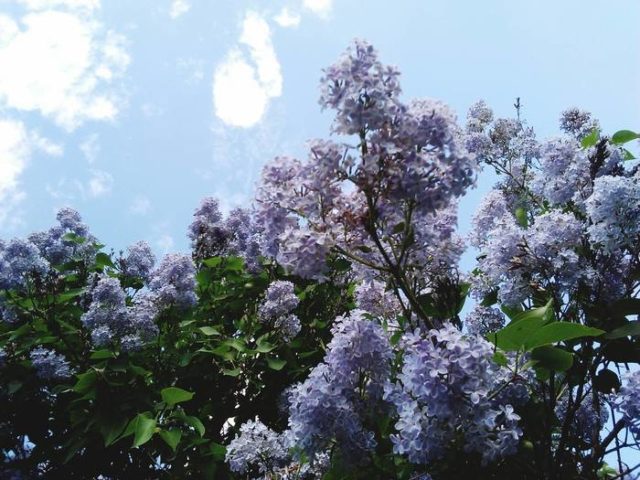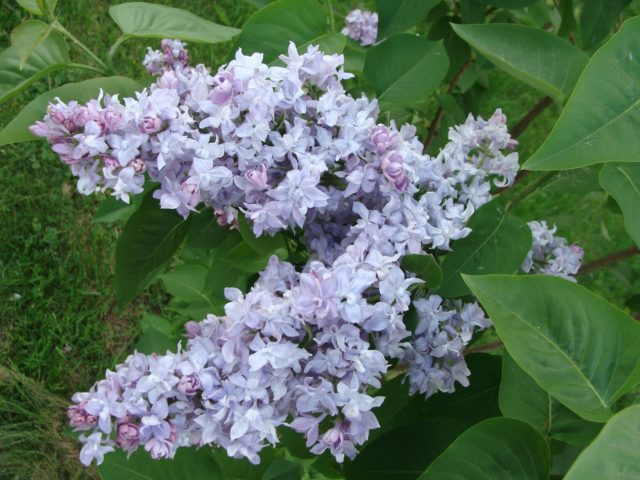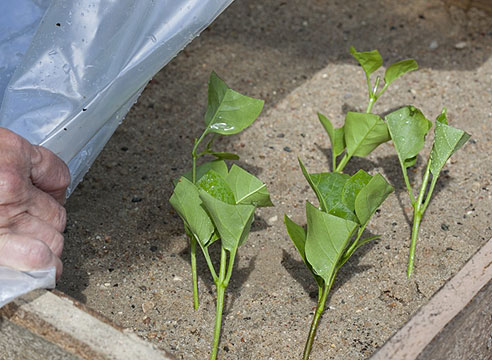Content
Lilac The sky of Moscow pleases not only Muscovites with blue and purple flowers every spring. The name of the variety is due to the fact that at the stage of active flowering, the lilac seems to merge with the color of the Moscow sky on a clear day, which is why.
Description of lilac Sky of Moscow
Common lilac varieties "Sky of Moscow" - one of the most popular species, artificially created by the Soviet selector L.I.Kolesnikov in the 40s - 70s. He also owns other Moscow varieties of lilacs - Krasavitsa Moscow and the Kremlin chimes.
This species is a short (2-3 meters), compact shrub that has an average flowering period of about 14 days, depending on weather conditions. At the same time, flowering is quite abundant.
Corollas consist of 3 or more petals, the diameter of which is 2 - 3 cm. The buds are formed in large inflorescences.
How lilac inflorescences The Moscow sky merge with the Moscow sky, you can see in the photo:
How the lilac blooms in the sky of Moscow
If you turn to the botanical reference books, you will notice that the Sky of Moscow is immediately attributed to three color groups. This is due to its unusual flowering, expressed in three shades at different stages of flowering, which is why it is also called chameleon lilac.
When the lilac sky of Moscow is just beginning to bloom, it is lilac, almost purple tones. Having fully blossomed, it changes color to bluish-purple, and when the buds fade - to white-blue.
Breeding features
Even an inexperienced gardener can propagate an ornamental bush. Successful reproduction requires only good lighting, wind protection and drainage against moisture stagnation. Therefore, basically, lilacs are cultivated in greenhouses. But its successful reproduction is not excluded in the conditions of the garden.
You can propagate a culture in the following ways:
- Cuttings... A stalk is cut from a bush and immersed in the ground. In this case, the lower cut is made obliquely, and the upper one - straight. The lower leaves are removed, the upper ones are cut in half. After soaking in a solution of a growth stimulator, drainage is laid in the garden bed and a cutting is planted;
- Growing from seeds... Seeds are harvested in late autumn and stratified within 2 months. Then they are planted in disinfected soil. For successful germination, it is desirable to create a microclimate for the seedlings from ordinary cling film;
- Root shoots... Carefully cut the root of the mother tree and plant it in moist soil. It is advisable to carry out the procedure until mid-October. For the winter, you need to provide the plant with shelter;
- Root layers... The lower branch of a young tree must be bent so that its middle part can be buried in the ground. Once the branch has taken root, it can be cut off from the mother tree. The method is relevant for planting rows of lilacs.
In addition, lilacs can be grafted, but this method requires special knowledge and experience.
Planting and caring for lilacs Sky of Moscow
Although the culture is unpretentious and lasts until late frosts, in order to get a strong tree that will not be susceptible to disease, it is better to adhere to some recommendations when planting.
Recommended timing
You can plant lilacs at any time, except in winter. The best time for planting is considered August and September. At this time, the earth is warm enough, and the plant is already beginning to prepare for the coming winter.
You can plant a culture at other times of the year, but then you will have to take additional measures to support it, since there is a great chance that the lilac will not take root.
Site selection and soil preparation
It is better to choose a place for planting lilacs based on the characteristics of the site. The Moscow Sky variety can be planted singly, in rows or hedges (at a distance of at least 1 m from each other). It is advisable to choose a sunny place. If you are planting a very small seedling or seeds, you need to provide protection from the wind. For example, choose a place near the fence, but so that the seedling receives enough sun.
For planting, you should not choose a site in the lowland, since the roots of the plant do not like stagnant moisture. If the entire site is located in a lowland, and the accumulation of moisture is inevitable, for the lilac it is necessary to make an embankment, like an alpine slide.
How to plant correctly
When planting seedlings, you need to dig a hole, the dimensions of which will correspond to the volume of the roots. The neck of the roots should be sunk 3 to 4 cm deep. If the seedling is grafted, its neck should look out 2 - 3 cm.
In the case when the soil is not fertile, it is better to add fertilizers in the form of compost, humus or tree resin. You should not add top dressing from the store or manure, as lilacs have rather sensitive roots and fertilizers can burn them.
Growing lilacs Sky of Moscow
Cultivation of the Heaven of Moscow variety does not take much time and includes procedures that are standard for most plants.
Watering
The sky of Moscow belongs to heat-resistant crops. If there is enough rainfall in the region, then there is no need to water the plant at all. If the seedling is planted in the spring, then it needs regular watering until the end of summer.
When the summer period is without rain, lilacs should be watered every 1 to 2 weeks. In this case, it is desirable to irrigate not only directly into the ground, but also to irrigate the crown itself. Lilacs especially need water during the flowering period.
Top dressing
Top dressing of lilacs is introduced in the 2nd - 3rd year of life. In this case, it is advisable to fertilize the soil with compost even during planting. An adult plant is fertilized in early spring with 65 g of ammonium nitrate and 50 g of urea. Starting from the 4th year of life, lilacs need to be periodically fed with organic fertilizers, this is also especially true during the flowering period.
Once every 3 years, the bush can be fertilized with phosphate fertilizers in accordance with the dosage indicated on the package. In the fall, while digging up the near-trunk earth, phosphates are introduced.
Mulching
For young seedlings, it is very important to create a mulch layer, especially for autumn planting. For this, peat, compost, leaves and humus are suitable. In this case, it is desirable that the layer is not less than 10 cm, for an adult lilac 5 cm is enough. The mulch layer should be renewed twice a year - in spring and autumn.
Pruning
Lilac bush Moscow sky is clipped after flowering. Are subject to pruning:
- all wilted buds;
- high branches - they are shortened by a third so that the bush does not go beyond 2 m;
- all basal processes.
Dry branches should also be removed. In addition, if the bush has become too wide, you can select the weak branches and prune them.
Preparing for winter
There is no need to prepare adult bushes for winter. Lilac The sky of Moscow feels great in the Moscow climatic conditions.
Only small seedlings protect from frost. To do this, it is enough to make a mound of mulch with a layer of 15 - 20 cm.
Diseases and pests
The variety Heaven of Moscow is characterized by the same diseases that suffer from other types of lilacs. Diseases are divided:
- on bacterial, in which the leaves quickly fade, and small spots appear on the rhizome;
- fungal, when moldy white spots appear on the leaves;
- infectious: when they are affected, whitening of the leaves is observed, the appearance on them and on the flowers of a mosaic color, a ring-shaped pattern, as well as foliage folds upwards.
The problem of growing lilacs is that the culture is difficult to treat, and in most cases it dies when damaged.Therefore, it is important to take preventive measures and buy seeds and seedlings of the plant in stores with the appropriate documents.
Among the pests that attack lilacs, one can distinguish - acacia pseudo-shytovnik, crabapple, lilac moth, leafhopper, weevil and leaf mite.
Treatment of the plant involves the purchase of special insecticides that can be used as a spray or during watering. Preventive measures include timely cutting and burning of the affected areas.
Conclusion
Lilac The sky of Moscow is distinguished by its tricolor coloring during flowering, which lasts for 14 days in late spring. The plant is unpretentious in cultivation, it is distinguished by high heat and frost resistance, as well as high decorative properties.











